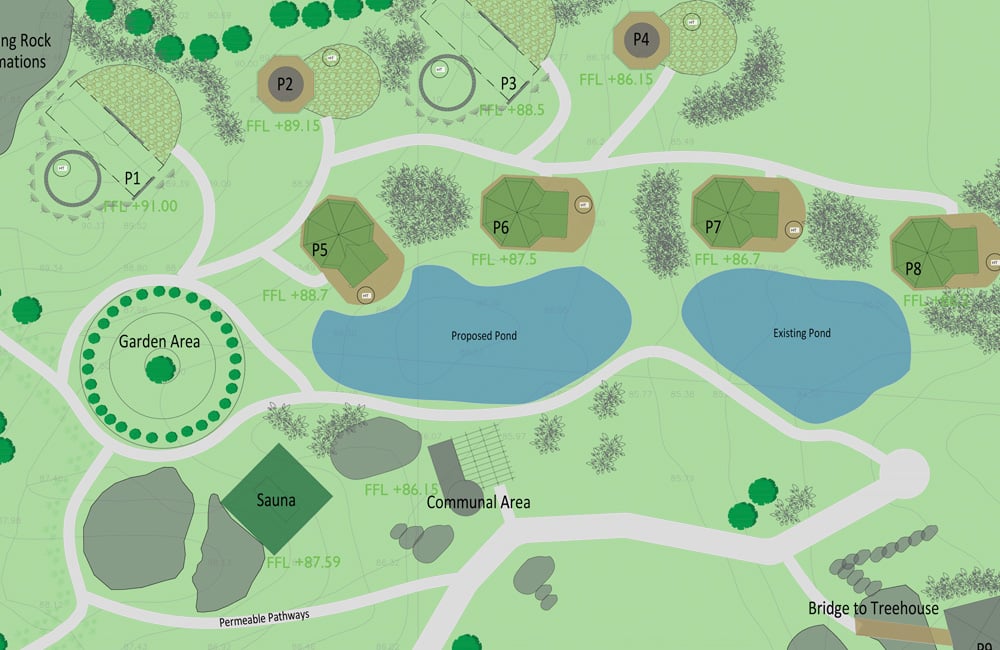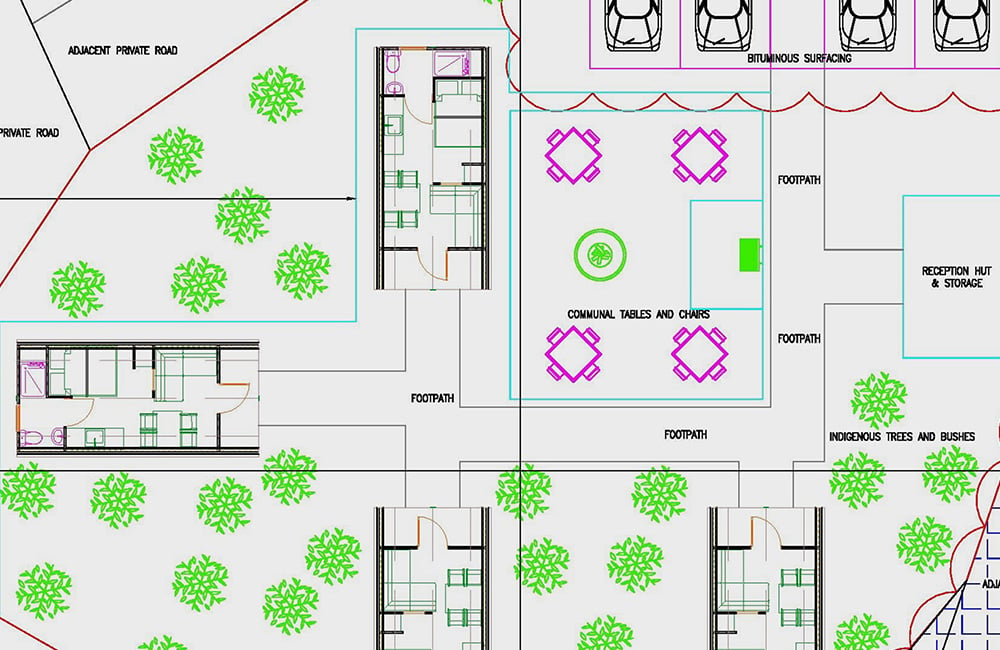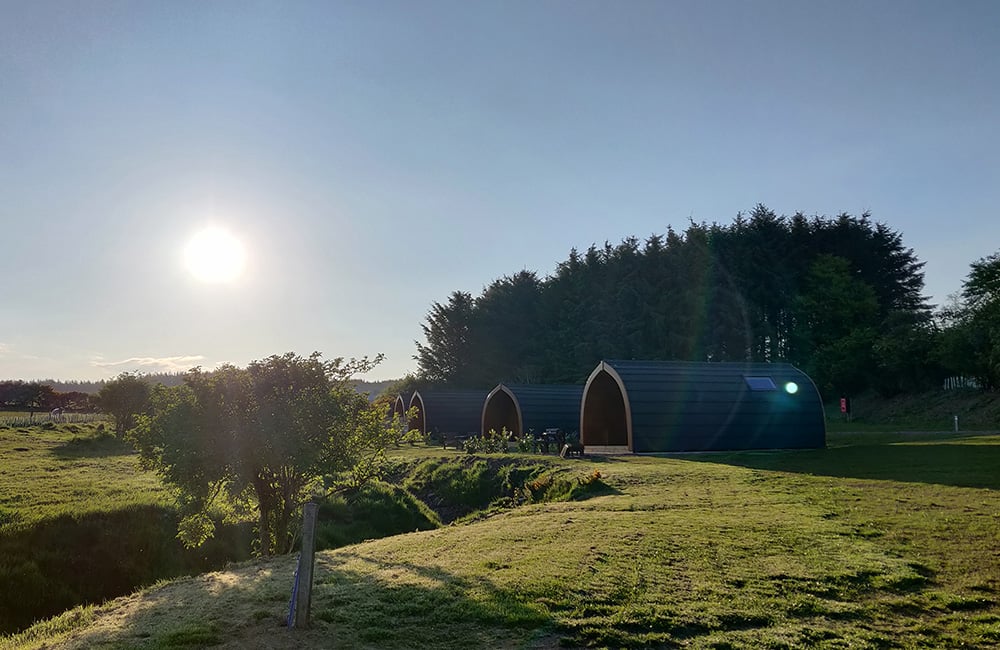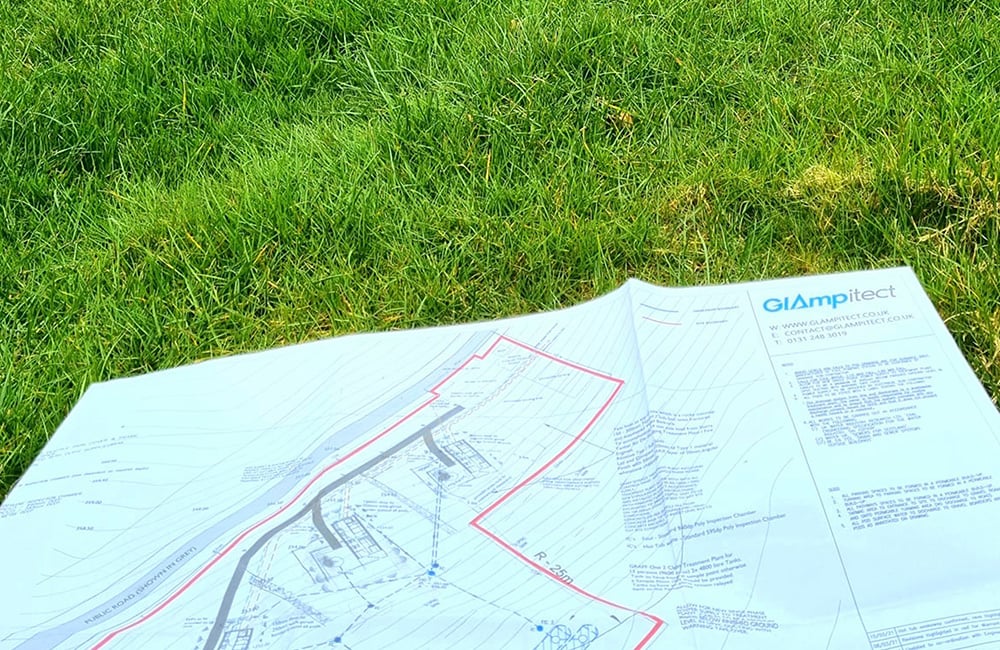Your Planning Questions Answered
Thinking of starting a glamping business but unsure about the ins and outs of getting glamping planning permission? We’ve got you covered. This page should answer every question you could possibly have and more about acquiring planning permission for your glamping business.
If you still have an unanswered question after reading this page, we promise we’ll answer it in a free consultation with one of our glamping experts.
If you prefer to read offline, we’ve created a free downloadable guide to planning permission for you to save and read at your leisure.

Do I Need Planning Permission for a Glamping Site?
The answer to this question is almost always yes.
If you want to start a glamping business that operates for more than 28 days, you’ll need planning permission. The UK government allows glamping/camping sites to operate without planning permission for 28 days per year, but these are subject to restrictive rules on development. For example, you can’t lay concrete bases or install treatment plants under the 28-day rule. 28-day operations can be useful testing grounds for your glamping idea, but the restrictions mean you’ll struggle to aim for the luxury end of the market that we typically recommend. You’ll also see very limited return on investment as you’ll be missing out on 11 months’ worth of guests.
You might think that you won’t need planning permission if you don’t need to develop your land to start a glamping site. For example, you could already have a private shepherd hut that you decide to lease out to guests. Yet, even though no development would be required in this case, you’ll still need to apply for permission for a change of use. Councils are rightfully protective of their communities, so with very limited exceptions they’ll require you to go through the planning process before allowing you to start making money from your land.
Will I Get Glamping Planning Permission?
It’s impossible to answer this question without actually submitting your application. Even the most detailed applications in council areas with the most glamping-friendly policy run the risk of being rejected. It’s important to remember that planning officers are human, so sometimes they’re not able or willing to make the right decision.
However, there are ways of ascertaining the likelihood of your application being accepted. One method requires an investment of time, while the other requires an investment of money.
Investing Time - Home Research
It’s possible to learn how good your chances of acquiring glamping planning permission are by investing a number of hours into some home research. This involves
(1) identifying how your land is designated
(2) trawling through your local council’s planning policy
(3) analysing how the council have responded to previous glamping planning applications in the area.
1) Identifying land designation
Every piece of land across the UK has been assigned at least one designation by their local council. For example, land in the middle of a town will be designated as falling within that particular settlement, while rural land will likely be considered ‘open countryside’. There are also more specific designations, such as green belt sites, sites of special scientific interest and conservation areas. These specific designations are typically restrictive and make it harder to acquire glamping planning permission, though they won’t necessarily be fatal to your application.
The easiest way of finding your land designation is by using the interactive maps on the planning section of your council’s website.
(2) Examining policy
Once you’ve identified how your land is designated, you need to match that designation to the relevant policy. Each council has its own local development plan that lists all of their planning policies that they measure applications against.
Your next task should be to look through the policies that match your land designation and consider how they relate to your glamping plans. You may find out that, for example, your council has a highly restrictive green belt policy that states development on green belt sites will be permitted only in exceptional circumstances.
As well as these policies that relate specifically to your land designation, you should also consider more general policies, such as your council’s policies on tourism, road access and sustainability.
Once you know your council’s rules on various aspects relating to your development, you’ll have a much clearer view of the outlook of your application.
(3) Analysing previous glamping applications
As useful as analysing policy on paper can be, sometimes what councils say on paper and what they do in practice are two very different things. That’s why it’s important to supplement policy research with an analysis of previous glamping site applications in the area. These are all available in the planning section of your council’s website. The most important documents to look at are the council’s comments on each application so you can see which issues they identified as the most significant and what the main stumbling blocks have historically been for glamping planning applications in your area.
So, in return for 10-15 hours of research, you’ll have a solid picture of how likely you are to acquire planning permission for your glamping site. Alternatively, you can save yourself the time and hassle by letting the experts do it for you with a Glampitect Feasibility Study.
Investing Money - Glampitect Feasibility Study
The easier way to ascertain your planning probability is to commission a Feasibility Study with Glampitect. We’ve produced over 500 of these since 2019 and we’ve got the process down to a fine art. We’re thorough, efficient and effective. Plus, not only do you get a planning probability assessment, you also receive a competitor analysis and in-depth financial projections covering your likely setup costs, ongoing costs, revenues, profits and return on investment. It’s all tailored to your glamping idea and it costs just £497 + VAT.
Feasibility Studies
Convinced? You can commission a Feasibility Study now through the Glampitect Shop.
Of course, while undertaking a feasibility assessment is important to assess your council’s attitude towards glamping projects, a positive feasibility outlook doesn’t guarantee that you’ll acquire planning permission. You still need to submit a professional, persuasive planning application that ticks all the boxes and address your council’s potential concerns. This will be covered in the next section.
What If I Open a Glamping Site Without Planning Permission?
Considering the strength of feelings neighbours sometimes have about a proposed glamping site in the area, you’re highly unlikely to be able to operate a permission-less glamping business without someone finding out and reporting it to the council.
If this happens, you’ll either have to retrospectively apply for permission (for which the odds of approval are lower thanks to the attempted deception) or return the land to its previous state. If you ignore these orders, you could face criminal prosecution.
How Do I Get Planning Permission for a Glamping Site?
Before You Submit Your Full Application - Consider Pre-Planning
Before submitting a full planning application for your glamping development, you typically have the option to go through the pre-planning process. This involves sending drawings and basic information about your glamping business to your local council, who will give you advice on whether your project is likely to receive planning consent. When the council responds, it doesn’t lead to a binding decision; rather, it’s merely an opportunity to receive valuable feedback on your idea and its suitability for the area. If the feedback is negative, it stops you wasting time and money on a full application, while anything more positive allows you to fine-tune your full application and maximise your chances of acquiring planning permission for your glamping business.
Should you go through pre-planning before submitting a formal planning application? It depends. If you’re confident that your application will be approved, it might make more sense to go straight to full planning. If you have doubts over your council’s willingness to approve your project, pre-planning represents a lower-risk option that effectively acts as an insurance policy. We covered this in greater detail in our blog on glamping pre-planning. A Glampitect Feasibililty Study will also help you decide which route to go down.

The Full Planning Application
A full planning application is the be-all and end-all. It’s where your glamping dreams will live or die. To acquire glamping planning permission, or any kind of planning permission for that matter, you’ll need to submit a detailed application to your local council. The planning committee will review your submission, consider neighbours’ objections and take on board comments made by public bodies such as the Highways Authority. They’ll then make a final decision on whether to approve or reject your application, with the interests of the local community being their primary consideration at all times.
What Should Be Included In a Full Planning Application?
Requirements vary from council to council, but here’s what we typically include in our clients’ applications:
- Proposed layout drawing
- Location plan
- Design & access statement
- Technical drawing
- Market research
- Road/parking plan drawing
- Artist’s impression
- Site selection report
- Drainage plan
- Access drawing
- Visibility splays
Can I Submit My Own Planning Application?
It’s possible, but we strongly recommend against it.
Of course, it’s in our interests to encourage you to use experts like us, but trust us when we say that most councils expect a high level of professionalism from glamping planning applications. Remember, it’s a proposal for a commercial operation, so an amateurish application isn’t going to reflect well on the project.
We often find ourselves ‘sweeping up’ low-quality, homemade applications, and believe us when we say it’s much easier for all parties if you use a professional from the start.
Got a question about getting glamping planning permission? Book a call with an expert consultant.
What Are Some Key Factors in Acquiring Glamping Planning Permission?
Every glamping application is different, but some elements are raised time and time again by councils in their policies and decisions. Here are three key ones.
Visual Impact
This is a pretty self-explanatory issue. Your local council isn't going to want to approve a development that creates a public eyesore. It’s important that your glamping units are well-screened by trees or other natural barriers, and that your site blends into its surroundings as much as possible.
Access
Once your application has been lodged with the council, they’ll seek consultation from a variety of public bodies, one of which is the local highways authority. They give their feedback on issues such as the level of traffic the site might generate and the suitability of the site’s proposed access points.
When designing your site, you must ensure that it’s easily and safely accessible by car. This should account for cars leaving the site too, as an exit point straight onto a 60mph bend would clearly be unsafe. If you need to create an access point, or your current access point is unsuitable, think carefully about the most suitable location.

Sustainability
Unsurprisingly, sustainability is becoming more and more important to councils. Almost every council has its own sustainability policy, and they treat adherence to these policies with great importance when it comes to making a decision on a glamping planning application.
Perhaps surprisingly, their focus isn’t necessarily on using solar panels and other green initiatives. Their main sustainability concern typically relates to reliance on cars as a means of transport to the site. For example, it’s hard to gain approval for a site that’s miles from the nearest town and has very few bus links, footpaths or cycle paths. They want to see less reliance on cars and a greater use of sustainable methods of travel.

Top Tips for Acquiring Glamping Planning Permission
Every application is different, but there are some best practices you should be following if you want to maximise your chances of having your glamping planning application approved:
Minimise your impact on the visual landscape
Your application stands a greater chance of success if your glamping site isn’t an eyesore. Strategically place your units behind trees, or plant new ones, so that the site is screened from view as much as possible.
Remember, you’re dealing with people, not robots
Your local council doesn't just blindly apply policy. They’re human, and are therefore as susceptible to emotion and bias as the rest of us. Remember that when you’re speaking to your planning officer. Always be polite, professional and prompt in your responses, even if the planning officer is the opposite.
Get your neighbours onside
Neighbour support is unlikely to have a huge impact on the outcome of your application, as councils typically focus more on the opinions of professional consultees (e.g. the highways agency). However, not having to worry about protests, threats, etc, will make your life a lot easier.
Use experts
You may just about get by with a homemade pre-planning application, but that won’t cut it when it comes to your full application. We’d estimate 75% of glamping planning applications are submitted by professional architects/designers like us, and those 75% have a much higher success rate. This is because the standard of drawings, research, written arguments, etc, is generally much higher when it’s done by someone who submits planning applications for a living.
Move Your Project Forward
Not only do we submit planning applications for a living, we specialise in glamping projects, so you can be sure we’re the best people to call if you want to acquire glamping planning permission.
Interested in moving your glamping project forward? Book a free consultation with one of our experts here.
Still Have Questions?
Get in touch with our glamping experts today and we can help you move forward on your glamping journey.






